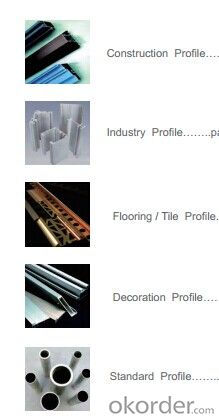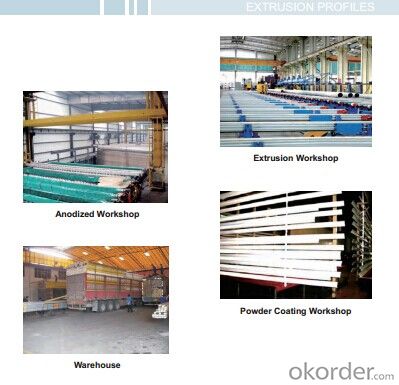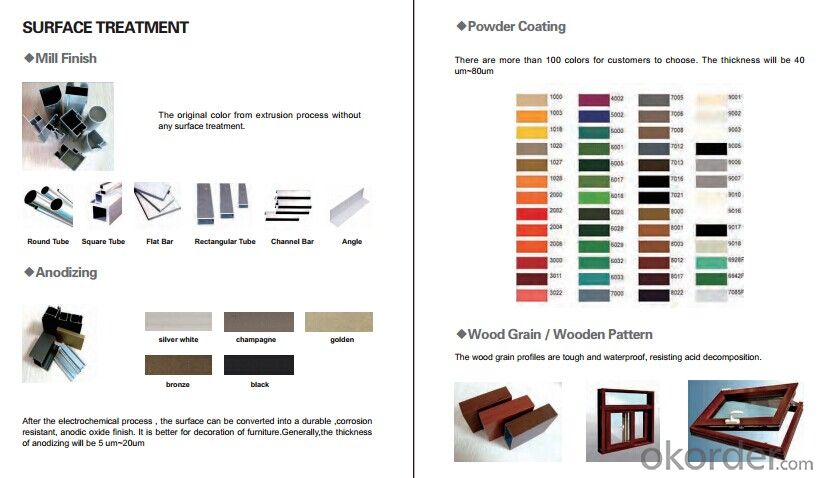slot aluminium profiles extrusions
- Loading Port:
- China Main Port
- Payment Terms:
- TT OR LC
- Min Order Qty:
- -
- Supply Capability:
- -
OKorder Service Pledge
OKorder Financial Service
You Might Also Like
Aluminium is a relatively soft,durable, lightweight, ductile and malleablemetal with appearance ranging from silvery to dull gray,depending on the surface roughness. It is nonmagnetic and does not easilyignite. A fresh film of aluminium serves as a good reflector (approximately92%) of visible light and an excellent reflector (as much as98%) of medium and far infrared radiation. The yield strength of pure aluminium is 7–11 MPa,while aluminium alloys have yield strengths ranging from200 MPa to 600 MPa. Aluminium has about one-third the density and stiffnessof steel. It iseasily machined,cast, drawn and extruded.
Aluminum Profile
Material | Alloy 6063,6061,6005or according to customer’s choice |
Temper | T3, T4, T5, T6 |
Surface | Anodize, electrophoresis, powder coating, PVDF coating, wood grain painting, matted, etc. |
Length | Coating 6.5 meters, Anodizing 6.5 meters, Mill finish 5 meters |
Application | Industrial, electrical equipment(TV set, air conditioner, refrigerator, computer), decoration,construction, transportation |
Custom Made | We can package following with customer's request. |



- Q:How to use aluminum profile on the side of roller conveyor?
- Aluminum profile inside 1 cm thick lining board, our unit of assembly line is like that
- Q:Are aluminum profiles suitable for exhibition booths?
- Yes, aluminum profiles are suitable for exhibition booths. They are lightweight, durable, and easy to assemble and disassemble, making them ideal for creating versatile and portable booth structures. Additionally, aluminum profiles offer a sleek and modern aesthetic, allowing for customization and branding opportunities.
- Q:What is the terminology to explain the aluminum twist and bending and a sharp respectively.
- Twist: the section on the platform, and one end of the platform. To achieve stable profiles by self, the gap on both sides of endpoint and platform for measuring the value of the section warping end of T1 and T2, T1 and T2 is the difference between the profiles of the twist.
- Q:What is the cost of aluminum profiles?
- Several factors can impact the cost of aluminum profiles, including the type of profile, required length and thickness, and prevailing market conditions. Typically, aluminum profiles are priced per linear foot or meter. Moreover, the price might be affected by the quality of the aluminum utilized and any necessary additional finishes or treatments. To obtain precise pricing details, it is recommended to reach out to local suppliers or manufacturers, as pricing can vary across regions.
- Q:Aluminum extrusion die, what material is better? Can reach long life, extruded products surface smooth and smooth?
- The main material used now is H13, which is the most common material usedThe problem of life not only with material, heat treatment with you, mold making, mold structure, relationship maintenance and other aspects in the use of Dongxin steel, specializing in the production of aluminum extrusion die material.
- Q:What are the different surface protection coatings for aluminum profiles?
- There are several different surface protection coatings available for aluminum profiles, each offering unique benefits and applications. Some common options include: 1. Anodizing: Anodizing is a widely used coating method that creates a protective layer on the surface of aluminum. It enhances the corrosion resistance, durability, and aesthetics of the profiles. Anodized coatings can be clear or colored, providing options for various design preferences. 2. Powder coating: Powder coating is a popular choice for aluminum profiles due to its durability and versatility. This coating method involves electrostatically applying dry powder to the surface, which is then cured under heat to form a protective layer. Powder coatings offer excellent resistance to UV rays, chemicals, and scratches, while also providing a wide range of color options. 3. Liquid paint coating: Liquid paint coatings are another option for protecting aluminum profiles. This method involves applying a liquid paint to the surface, which is then cured to form a protective film. Liquid paints offer flexibility in terms of color and finish, allowing for customization to meet specific design requirements. 4. E-coating: E-coating, also known as electrocoating or electrodeposition, is a method of applying a paint or coating to aluminum profiles using an electric current. This process creates a uniform and consistent coating, providing excellent corrosion resistance and durability. E-coatings are commonly used in automotive and industrial applications. 5. Ceramic coatings: Ceramic coatings are a newer option for protecting aluminum profiles. These coatings are composed of inorganic materials that provide exceptional hardness, heat resistance, and chemical resistance. Ceramic coatings can enhance the performance and lifespan of aluminum profiles in harsh environments, such as marine or aerospace applications. It is important to consider the specific requirements and intended use of the aluminum profiles when selecting a surface protection coating. Factors such as corrosion resistance, durability, aesthetics, and cost should be taken into account to determine the most suitable coating option.
- Q:Can aluminum profiles be used in the construction of retail displays?
- Yes, retail displays can utilize aluminum profiles in their construction. Aluminum is a versatile and lightweight material that finds common application in various industries, such as construction and retail. It provides several benefits for retail displays, including durability, resistance to corrosion, and ease of customization. Aluminum profiles can be effortlessly shaped and fabricated to create diverse types of retail displays like shelving units, display stands, signage frames, and product showcases. These profiles can be extruded into different shapes and sizes, enabling flexibility in design and functionality. Moreover, aluminum profiles can undergo various surface treatments, such as anodizing or powder coating, to enhance their appearance and offer a protective layer against scratches and wear. This ensures that retail displays can maintain their aesthetic appeal and withstand the demands of a retail setting. Furthermore, aluminum is an eco-friendly material due to its high recyclability, making it an environmentally conscious choice for retail displays. It can be easily recycled without losing its properties, thus reducing the environmental impact of the construction and retail industries. To summarize, aluminum profiles are a practical and appropriate option for constructing retail displays. They provide durability, versatility, and customization possibilities while being lightweight and environmentally friendly.
- Q:Can aluminum profiles be used for exhibition stands?
- Yes, aluminum profiles can be used for exhibition stands. Aluminum profiles are lightweight and versatile, making them an ideal choice for exhibition stands. They can be easily assembled and disassembled, allowing for easy transportation and storage. Additionally, aluminum profiles can be customized to fit the specific design and layout requirements of an exhibition stand. They can be used to create frames, partitions, and display panels, providing a sturdy and professional-looking structure. The use of aluminum profiles in exhibition stands also offers the flexibility to add accessories such as lighting fixtures, shelving, and signage, further enhancing the overall visual appeal and functionality of the stand.
- Q:How can I distinguish the aluminum profiles in the building and the aluminum in the industry?
- Door frames, aluminum profiles and doors and windows, aluminum profiles are in the building. Your picture is a line of scaffold material, usually in industrial material.
- Q:Can aluminum profiles be used in telecommunications infrastructure?
- Telecommunications infrastructure can indeed utilize aluminum profiles. Aluminum, a versatile and lightweight material, boasts numerous benefits in telecommunications applications. It possesses corrosion resistance, making it ideal for outdoor setups exposed to severe weather. Moreover, aluminum profiles are easily fabricated and customizable, allowing for specific requirements like mounting brackets, cable trays, or equipment racks. Additionally, aluminum profiles possess outstanding electrical conductivity, a crucial aspect in telecommunications infrastructure for efficient signal transmission. They find utility in constructing transmission towers, antenna supports, and base stations, serving various purposes. Furthermore, aluminum stands out as a sustainable material, as it can be recycled repeatedly without compromising its properties. This aligns with the growing emphasis on environmental sustainability within the telecommunications industry. To sum up, aluminum profiles present a cost-effective and reliable solution for telecommunications infrastructure, offering durability, flexibility, and exceptional electrical conductivity.
1. Manufacturer Overview |
|
|---|---|
| Location | |
| Year Established | |
| Annual Output Value | |
| Main Markets | |
| Company Certifications | |
2. Manufacturer Certificates |
|
|---|---|
| a) Certification Name | |
| Range | |
| Reference | |
| Validity Period | |
3. Manufacturer Capability |
|
|---|---|
| a)Trade Capacity | |
| Nearest Port | |
| Export Percentage | |
| No.of Employees in Trade Department | |
| Language Spoken: | |
| b)Factory Information | |
| Factory Size: | |
| No. of Production Lines | |
| Contract Manufacturing | |
| Product Price Range | |
Send your message to us
slot aluminium profiles extrusions
- Loading Port:
- China Main Port
- Payment Terms:
- TT OR LC
- Min Order Qty:
- -
- Supply Capability:
- -
OKorder Service Pledge
OKorder Financial Service
Similar products
New products
Hot products
Hot Searches
Related keywords





























